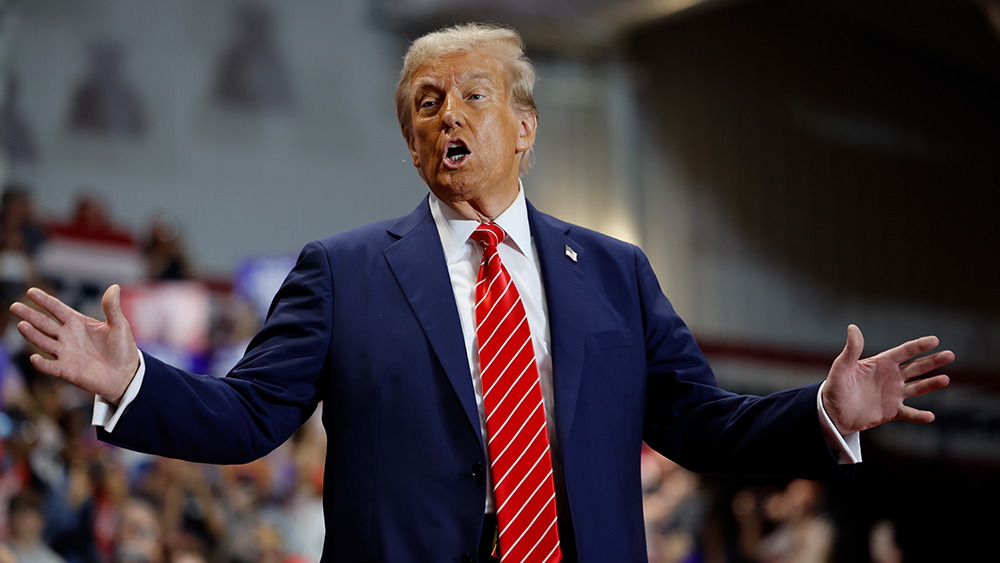The gold market's new reality: U.S. repatriation and delivery logistics stress the Bank of England
By willowt // 2025-02-10
Tweet
Share
Copy

- The Bank of England (BOE) is facing unprecedented challenges as demand for physical bullion surges, particularly from the United States, leading to a rare discount on BOE-stored gold.
- The situation is exacerbated by logistical bottlenecks and concerns over potential tariffs, with the BOE experiencing weeks-long queues for gold withdrawals due to an influx of bullion banks seeking to borrow gold.
- This development underscores a broader trend of gold repatriation, especially from the United States, and highlights the growing demand for physical gold, which is impacting the traditional dominance of London in the global gold market.
- The tight gold market is reflected in soaring lease rates and backwardation, indicating a high demand for gold, with lease rates for gold in London reaching about 4.7% and the LBMA PM gold price setting new record highs.
- The 2025 outlook suggests that central banks and ETF investors will continue to drive gold demand, supported by economic uncertainty, but may put further pressure on the gold jewelry market, which has already seen a decline in consumption.
Gold rush and tariff turmoil
According to a recent Bloomberg report, gold stored in the Bank of England's vaults is trading at a discount of more than $5 an ounce below the spot price in London. This discount is highly unusual, as gold at the BOE typically trades in lockstep with the rest of the London market. The divergence is driven by a rush to secure physical bullion in the face of potential tariffs imposed by the Trump administration, which has not specifically targeted precious metals but has raised concerns among traders. "The size of the divergence is extremely unusual, with gold at the BOE usually trading in lockstep with prices in the rest of the London market," said Robert Gottlieb, a former precious metals trader and managing director at JPMorgan Chase. "The bottleneck was created by an onslaught of bullion banks looking to borrow gold from central banks at the Bank of England, and the fact that the BOE is not a commercial vault and is not prepared to handle this, thus creating queues." The situation has created weeks-long queues to withdraw gold from the BOE, making it less attractive than bullion held in more accessible commercial vaults around London. This logistical strain is not just a temporary issue but a symptom of a broader trend: the world's growing demand for physical gold, particularly from the United States.Repatriation and market dynamics
The current situation is part of a larger trend of gold repatriation, with the United States leading the charge. Central banks and investors are increasingly seeking to bring their gold holdings back to their home countries, driven by a combination of economic uncertainty, geopolitical tensions and the desire for greater control over their assets. Historically, London has been the epicenter of the global gold market, with the London Bullion Market Association (LBMA) setting the benchmark for gold prices. However, the current logistical challenges and the discount on BOE gold suggest that London's dominance may be waning. The LBMA is aware of the concerns and is working closely with market participants to address the issues, but the situation highlights the vulnerability of a system that relies heavily on the BOE's infrastructure. John Reade, a senior market strategist at the World Gold Council, noted, "I suppose having their gold at the Bank of England is a decision that some people may be regretting at the moment and maybe that’ll cause them to rethink it and keep it with a commercial vault, albeit at a higher expense."Financial implications and future outlook
The financial implications of this shift are significant. One-month lease rates for gold in London have soared to about 4.7%, far above the usual level of close to zero. This indicates a tight market for gold, with holders of bullion in London's vaults earning a higher return by loaning out their metal on a short-term basis. The backwardation in the gold market, where forward prices are below spot rates, is another sign of the current tightness. Central banks and investors are not the only ones driving this trend. The demand for gold in 2024 reached a record annual total of 4,974 tons, with central banks buying more than 1,000 tons for the third year in a row. The LBMA (PM) gold price also reached 40 new record highs during 2024, with the average Q4 price of US 2,663/oz setting a new annual average price of US 2,386/oz, a 23% increase from the previous year. The demand for gold in value terms also reached unprecedented levels, with the combination of record gold prices and volumes producing a Q4 value of US 111 billion and an annual value of US 382 billion. However, the demand for gold jewelry dropped by 11% to 1,877 tons, reflecting the economic pressures on consumers. Looking ahead, the 2025 full-year outlook suggests that central banks and ETF investors will continue to drive demand, with economic uncertainty supporting gold's role as a risk hedge. However, this demand will likely keep pressure on the gold jewelry market, which has already seen a significant decline in consumption. In conclusion, the current situation at the Bank of England is a microcosm of the broader changes in the global gold market. As the United States and other nations continue to repatriate their gold, and as logistical challenges strain traditional financial centers, the balance of power in the gold market may shift, with far-reaching consequences for investors, central banks and the global economy. Sources include: ZeroHedge.com Bloomberg.com Gold.orgTweet
Share
Copy
Tagged Under:
collapse market crash UK US risk Gold Bullion money supply bubble Precious Metals repatriation tariffs trade wars currency reset Bank of England gold prices currency crash economic riot finance riot gold report market surge
You Might Also Like
Argentine president Javier Milei faces impeachment over $107 million crypto scandal
By Cassie B. // Share
Here’s why capital is fleeing Europe… And why the climate scam is to blame
By News Editors // Share
The price of green idealism: How Europe’s climate agenda is tanking its economy
By Willow Tohi // Share
Trump unveils reciprocal tariffs to level trade playing field, targets VAT systems
By Cassie B. // Share
Recent News
U.S. manufacturers see surge in orders as tariffs reshape supply chains
By lauraharris // Share
USDA cracks down on SNAP benefit fraud in nationwide operation
By lauraharris // Share
Florida passes bill to ban geoengineering and criminalize weather modification
By lauraharris // Share











